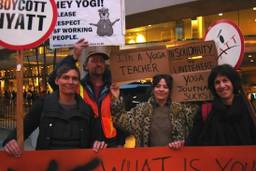After suing 26 of its former members, SEIU finally gets day in court
Going to court can make anyone nervous. But in civil court, where breach of contract disputes are normally settled, the stakes are not quite as high as in criminal court. You can’t be thrown in jail. That’s a plus.
But there are also disadvantages for defendants in civil cases. There are no public defenders to exempt the accused from court costs. While the outcome of any legal proceeding is uncertain, civil court defendants are acutely aware from the very beginning that they may be stuck with the costs of litigation.
I think about this as I prepare to attend the opening of a civil trial next week in San Francisco federal court, where one of the oldest and largest unions in America — the Service Employees International Union (SEIU) — is suing individual leaders of one of the nation’s youngest unions — the National Union of Healthcare Workers.
The 1.8 million-member Service Employees International Union (SEIU) has already spent, according to critics, an estimated $10 million to sue 26 individuals who are former officers, organizers and staffers of SEIU’s third largest chapter, the California-based United Healthcare Workers West (UHW).
The trial comes one year after SEIU officials from Washington, D.C., seized control of UHW in what’s widely understood as a political coup — or a civil war. For several years, the 150,000-member UHW had been voicing criticism of SEIU’s top-down style of leadership that was increasingly stripping members of their democratic rights and undermining workers’ wages and benefits.
In January 2009, SEIU officials removed the union’s elected officers and suspended its constitution after UHW’s 100-member Executive Board insisted that 65,000 of the union’s members should have a right to a democratic vote before SEIU leaders transferred them to another SEIU affiliate with a history of tolerating corruption and negotiating substandard wages and benefits for its members.
As members of UHW, these 65,000 homecare and nursing home workers had enjoyed some of the best contracts in the industry.
Furthermore, they objected to SEIU’s plan to separate them from 85,000 UHW hospital workers whose industrial power and industry-leading wages and benefits gave them an important strategic advantage.
After SEIU leaders seized control of UHW, UHW’s Executive Board voted to form a new, independent union called the “National Union of Healthcare Workers” (NUHW). More than 100,000 workers petitioned to switch to NUHW in the first 10 weeks.
SEIU has responded to this member-led rebellion by pouring massive resources into California in a frantic effort to stop the break-away union. That’s where next week’s trial, which begins on March 22, comes in.
SEIU, which appears to have declining support among workers when in competition with NUHW, has used costly lawsuits and other legal interventions as its main weapon against the break-away union.
Its current lawsuit claims the 26 individuals breached their fiduciary duties because they resisted SEIU International President Andy Stern’s takeover of UHW. Supporters of the defendants describe Stern’s scurrilous civil charges as a smokescreen to conceal the underlying political reasons for the trusteeship.
In the run-up to the trusteeship, UHW’s Executive Board voted repeatedly to defend its members’ rights and to pursue democratic reforms inside SEIU according to Fred Seavey, former research director of UHW. Seavey told In These Times, “You can’t wage full-out attack against our members’ right to vote and not expect our local union to defend itself.”
His comments point to a critically important different conception of unionism somewhat obscured within this legal dispute. “They claim we have a fiduciary responsibility to the SEIU national office,” Seavey stated, “but we say it’s to our members who elect us and pay us. We stand for representative unionism and not bureaucratic officialdom.”
NUHW organizes workers, SEIU files lawsuits
In fact, next week’s trial is the third time SEIU officials have sued many of the same former leaders of UHW during the past 18 months. SEIU’s first lawsuit was thrown out with prejudice by a federal judge and the second was settled after SEIU faced a credible countersuit by NUHW.
If one of SEIU’s charges is successful in court, it would clearly pose a dangerous precedent. Essentially, SEIU’s novel legal theory would mean that every time new union leaders take office, the previous leaders could be sued for funds spent on initiatives opposed by the international union.
It would have a chilling effect on free speech throughout the labor movement since local union leaders would be reluctant to seek reforms or criticize International union officials for fear of facing personal financial liability for their actions.
Along with its lawsuit, SEIU has waged an aggressive public-relations attack against the new union. It’s sent hundreds of SEIU organizers into California healthcare facilities armed with slick, glossy leaflets spreading slippery, unfounded attacks against NUHW.
Interestingly, SEIU’s most extravagant claims are conspicuously absent from its lawsuit – an admission that their charges have no basis in fact. For example, SEIU officials have repeatedly told workers that the former UHW leaders stole $3 million from the union’s strike fund. This slanderous claim, which is contradicted by SEIU’s own financial records and public statements, is nowhere mentioned in its lawsuit or any other legal proceeding.
Despite SEIU’s best efforts to bleed NUHW of its resources and support, it has not only survived but has grown quickly to genuinely establish itself as a viable challenger to SEIU’s monopolistic claims to represent healthcare workers in California.
NUHW has recently recruited 3,357 members in seven hard-fought victories during nine head-to-head election contests against SEIU, startling intractable foes and energizing growing numbers of enthusiastic supporters.
The union proudly boasts that these numbers, though still modest, make it the fastest growing labor organization in California. Tens of thousands of other workers continue to wait for elections that SEIU has delayed for more than a year through other frivolous legal interventions.
Less than a year ago, the whole NUHW project began with little more than an honest and sincere pledge of preserving democratic unionism. Beginning without any formal dues-paying members, many doubted their chances of success. Today, one can see the tide is turning.
To be sure, major tests lie ahead as nearly 50,000 California Kaiser workers gather petitions requesting National Labor Relations Board (NLRB) elections so they can join NUHW. But solidarity commitments from hundreds of veteran worksite leaders and staff volunteers have so far enabled the fledgling upstart to withstand everything the much-larger international union has thrown at them.
It is not without reason that NUHW has inspired many to support their courageous stand for union democracy against such a formidable opponent.
It is also not without reason that a growing number of pro-labor academic, political and community observers are concluding that it is shameful for a great international union to repeatedly harass and persecute dissident voices who wanted nothing more than the right to vote against actions of their national headquarters that would have bureaucratically torn apart their powerful united local.
Hopefully, broader principles of solidarity will soon replace the current narrow and divisive pursuits of the larger organization. I will be in court on March 22 hoping that justice prevails as well.
Carl Finamore is a delegate to the San Francisco Labor Council and former President (ret), Air Transport Employees, Local Lodge 1781, IAMAW.







